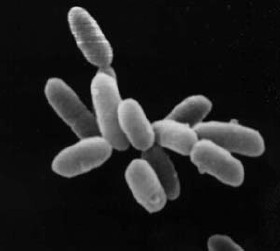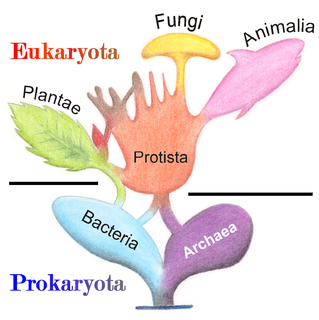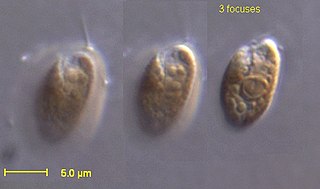Related Research Articles

Gram-negative bacteria are bacteria that do not retain the crystal violet stain used in the Gram staining method of bacterial differentiation. They are characterized by their cell envelopes, which are composed of a thin peptidoglycan cell wall sandwiched between an inner cytoplasmic cell membrane and a bacterial outer membrane.
In biology, a kingdom is the second highest taxonomic rank, just below domain. Kingdoms are divided into smaller groups called phyla. Traditionally, some textbooks from the United States and Canada used a system of six kingdoms while textbooks in Great Britain, India, Greece, Brazil and other countries use five kingdoms only. Some recent classifications based on modern cladistics have explicitly abandoned the term kingdom, noting that some traditional kingdoms are not monophyletic, meaning that they do not consist of all the descendants of a common ancestor. The terms flora, fauna, and, in the 21st century, funga are also used for life present in a particular region or time.
In biological taxonomy, a domain, also dominion, superkingdom, realm, or empire, is the highest taxonomic rank of organisms in the three-domain system of taxonomy devised by Carl Woese et al. in 1990.

The three-domain system is a biological classification introduced by Carl Woese et al. in 1990 that divides cellular life forms into archaea, bacteria, and eukaryote domains. The key difference from earlier classifications is the splitting of archaea from bacteria.

Excavata is a major supergroup of unicellular organisms belonging to the domain Eukaryota. It was first suggested by Simpson and Patterson in 1999 and introduced by Thomas Cavalier-Smith in 2002 as a formal taxon. It contains a variety of free-living and symbiotic forms, and also includes some important parasites of humans, including Giardia and Trichomonas. Excavates were formerly considered to be included in the now obsolete Protista kingdom. They are classified based on their flagellar structures, and they are considered to be the most basal flagellate lineage. Phylogenomic analyses split the members of Excavata into three different and not all closely related groups: Discobids, Metamonads and Malawimonads. Except for Euglenozoa, they are all non-photosynthetic.

Euryarchaeota is a phylum of archaea. Euryarchaeota are highly diverse and include methanogens, which produce methane and are often found in intestines, halobacteria, which survive extreme concentrations of salt, and some extremely thermophilic aerobes and anaerobes, which generally live at temperatures between 41 and 122 °C. They are separated from the other archaeans based mainly on rRNA sequences and their unique DNA polymerase.
The Aquificota phylum is a diverse collection of bacteria that live in harsh environmental settings. The name Aquificota was given to this phylum based on an early genus identified within this group, Aquifex, which is able to produce water by oxidizing hydrogen. They have been found in springs, pools, and oceans. They are autotrophs, and are the primary carbon fixers in their environments. These bacteria are Gram-negative, non-spore-forming rods. They are true bacteria as opposed to the other inhabitants of extreme environments, the Archaea.

Deinococcota is a phylum of bacteria with a single class, Deinococci, that are highly resistant to environmental hazards, also known as extremophiles. These bacteria have thick cell walls that give them gram-positive stains, but they include a second membrane and so are closer in structure to those of gram-negative bacteria.

The two-empire system was the top-level biological classification system in general use before the establishment of the three-domain system. It classified cellular life into Prokaryota and Eukaryota as either "empires" or "superkingdoms". When the three-domain system was introduced, some biologists preferred the two-superkingdom system, claiming that the three-domain system overemphasized the division between Archaea and Bacteria. However, given the current state of knowledge and the rapid progress in biological scientific advancement, especially due to genetic analyses, that view has all but vanished.

Amorphea are members of a taxonomic supergroup that includes the basal Amoebozoa and Obazoa. That latter contains the Opisthokonta, which includes the Fungi, Animals and the Choanomonada, or Choanoflagellates. The taxonomic affinities of the members of this clade were originally described and proposed by Thomas Cavalier-Smith in 2002.

The tree of life or universal tree of life is a metaphor, model and research tool used to explore the evolution of life and describe the relationships between organisms, both living and extinct, as described in a famous passage in Charles Darwin's On the Origin of Species (1859).
The affinities of all the beings of the same class have sometimes been represented by a great tree. I believe this simile largely speaks the truth.

Neomura is a possible clade composed of the two domains of life of Archaea and Eukaryota. The group was named by Thomas Cavalier-Smith in 2002. Its name means "new walls", reflecting his hypothesis that it evolved from Bacteria, and one of the major changes was the replacement of peptidoglycan cell walls with other glycoproteins. As of August 2017, the neomuran hypothesis is not accepted by most workers; molecular phylogenies suggest that eukaryotes are most closely related to one group of archaeans and evolved from them, rather than forming a clade with all archaeans.

Gracilicutes is a clade in bacterial phylogeny.

The PVC superphylum is a superphylum of bacteria named after its three important members, Planctomycetota, Verrucomicrobiota, and Chlamydiota. Cavalier-Smith postulated that the PVC bacteria probably lost or reduced their peptidoglycan cell wall twice. It has been hypothesised that a member of the PVC clade might have been the host cell in the endosymbiotic event that gave rise to the first proto-eukaryotic cell.
Eobacteria is a proposed clade characterized by Cavalier-Smith. Species in this group lack lipopolysaccharide.

The FCB group is a superphylum of bacteria named after the main member phyla Fibrobacterota, Chlorobiota, and Bacteroidota. The members are considered to form a clade due to a number of conserved signature indels.
Bacterial taxonomy is the taxonomy, i.e. the rank-based classification, of bacteria.
There are several models of the Branching order of bacterial phyla, one of these was proposed in 1987 paper by Carl Woese.
There are several models of the Branching order of bacterial phyla, one of these was proposed in 2002 and 2004 by Thomas Cavalier-Smith. In this frame of work, the branching order of the major lineage of bacteria are determined based on some morphological characters, such as cell wall structure, and not based on the molecular evidence.

Cryptista is a clade of algae-like eukaryotes. It is most likely related to Archaeplastida which includes plants and many algae, within the larger group Diaphoretickes.
References
- ↑ Cavalier-Smith T (2006). "Rooting the tree of life by transition analyses". Biol. Direct. 1 (1): 19. doi:10.1186/1745-6150-1-19. PMC 1586193 . PMID 16834776.
- ↑ Cavalier-Smith T (January 2010). "Deep phylogeny, ancestral groups and the four ages of life". Philos. Trans. R. Soc. Lond. B Biol. Sci. 365 (1537): 111–32. doi:10.1098/rstb.2009.0161. PMC 2842702 . PMID 20008390.